Curbing Your GPU's Power Use: Is It Worthwhile?
In many cases, the graphics card is the most power-hungry component in a PC. The enthusiast community is no stranger to CPU tweaking, so why hasn't GPU modification caught on? We're going to see just how much you stand to gain (or lose) from tweaking.
PowerTune: Taming Cayman
PowerTune
AMD introduced a feature called PowerTune with its Cayman-based cards. Simply put, you can think of PowerTune as a power cap for graphics cards. Can we use it to more granularly control power consumption? If the answer is yes, it would be pretty handy for users who do not have voltage adjustments available on their graphics cards.
We're going to test the Radeon HD 6970 at its default settings in our effort to gauge the usefulness of PowerTune. That means no voltage adjustments and no core or memory clock changes. The only variable we're changing is the PowerTune slider in AMD’s Catalyst Control Center, setting it to '-20'. For reference, we're also including results with the same clocks and the PowerTune slider set to 0 (its default setting). We're also including results from running the Radeon HD 6970 at 500/1030 MHz and 0.85 V.
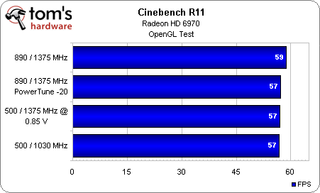

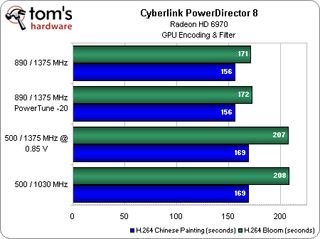
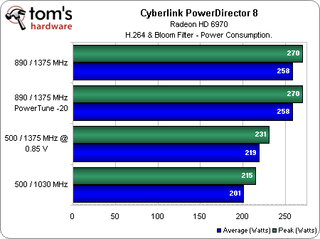
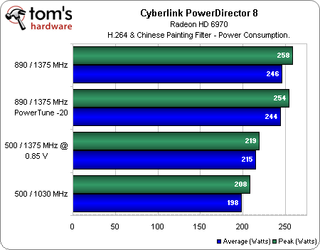
Judging by the power consumption numbers, there doesn't seem to be any difference between the settings. The most likely explanation is that PowerTune simply isn't kicking in. If an application does not push the GPU to the point where PowerTune is needed to help scale back thermal load, then the card continues to operate without constraint.

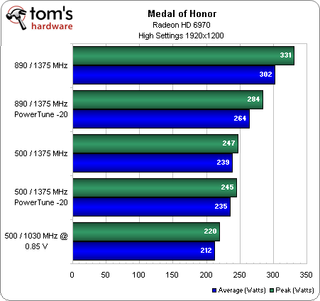
In Medal of Honor, which is more GPU-intensive, PowerTune does kick in. At full clocks, setting PowerTune to -20 offers some savings, but the savings are smaller than running at UVD clocks. You incur less of a performance hit, and minimum frame rates are similar. At UVD clocks, PowerTune doesn't seem to offer any additional savings, probably because the card doesn’t come anywhere near approaching its thermal ceiling at these lower frequencies.

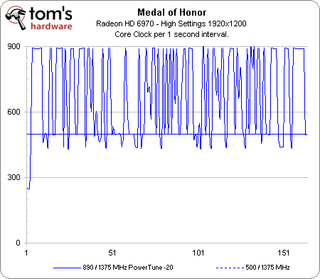
It's clear that PowerTune effectively changes operating frequencies dynamically when it considers power usage in excess of its limits.
Stay on the Cutting Edge
Join the experts who read Tom's Hardware for the inside track on enthusiast PC tech news — and have for over 25 years. We'll send breaking news and in-depth reviews of CPUs, GPUs, AI, maker hardware and more straight to your inbox.
Using PowerTune to cap power consumption does work, though it’s limited to games and applications with very high GPU utilization. In contrast, the UVD trick works regardless of the software you use. It also offers higher power consumption savings. To its credit, PowerTune is more convenient, since you can save the settings as a switchable profile in Catalyst Control Center.
Current page: PowerTune: Taming Cayman
Prev Page A Quick Gaming Test: Medal Of Honor Next Page Conclusion: Doable, But No Walk In The Park-
I think, considering those people using SLi and crossfire and higher end videocards, they don't really give a gat about how much elec. they are using. They can afford to buy two expensive PCBs, why would they care about extra 5~10 bucks per month? If poeple are focused on lower power consumption, they would go for lower performance components, arent they?Reply
-
anttonij I guess the most important point of this review is that you can lower the cards voltage while running at stock speed. For example I'm running my GTX 460 (stock 675/1800@1.012V) at 777/2070@0.975V or if I wanted to use the stock speeds, I could lower the voltage to 0.875V. I've also lowered the fan speeds to allow the card to run almost silently even at full load.Reply -
Khimera2000 @.@ there is no apple @.@Reply
This is neat though :) I wonder if this article might inspire someone to make an application. Come on open source dont fail me now >. -
Could you do comparison of "the fastest VC" vs "entry level" and then show us how much money we might end up paying each month or day?Reply
-
the_krasno Manufacturers should find a way to implement this automatically, imagine the possibilities!Reply -
wrxchris @OvaCerReply
I have 2 gfx cards pushing 3 displays, but I'm all for saving watts wherever I can. Our society has advanced to the point where sustainability is a very important buzzword that is widely ignored by mainstream media and many corporations, and this ignorance trickles down to the mainstream like Reaganomics. Minuscule reductions such as 30w savings across hundreds of thousands if not millions of users adds up to a significant reduction in carcinogenic emissions and saves valuable resources for future consumption. -
neiroatopelcc So when playing video, you risk your amd card going into uvd mode? What models does that apply to?Reply
I want to know, cause for instance in a raid, I'd sometimes watch video content on another screen while waiting around for whatever there is to wait for. I already lose the crossfire performance because of window mode. I don't want to lose even more.
Does my ancient 4870x2 support uvd? -
jestersage so... for the dual bios HD6900s, I can RBE one bios with my desired settings and just choose which bios to use before I power up my PC? hmmm... interesting.Reply
Most Popular

